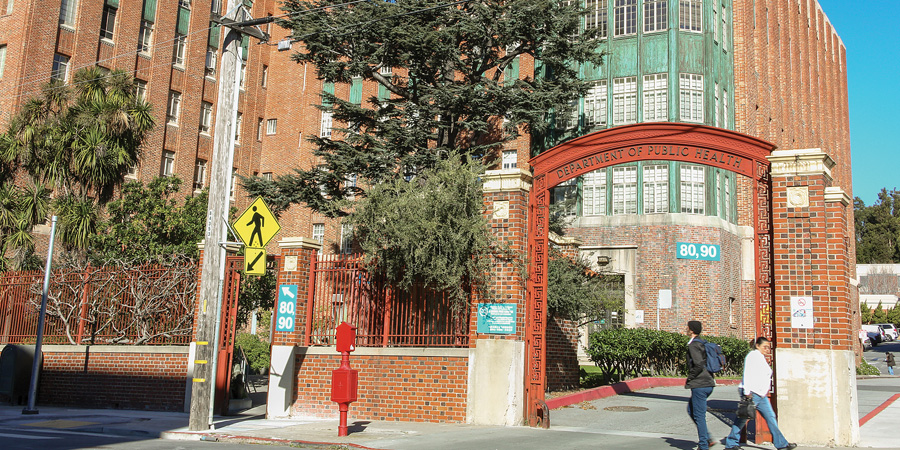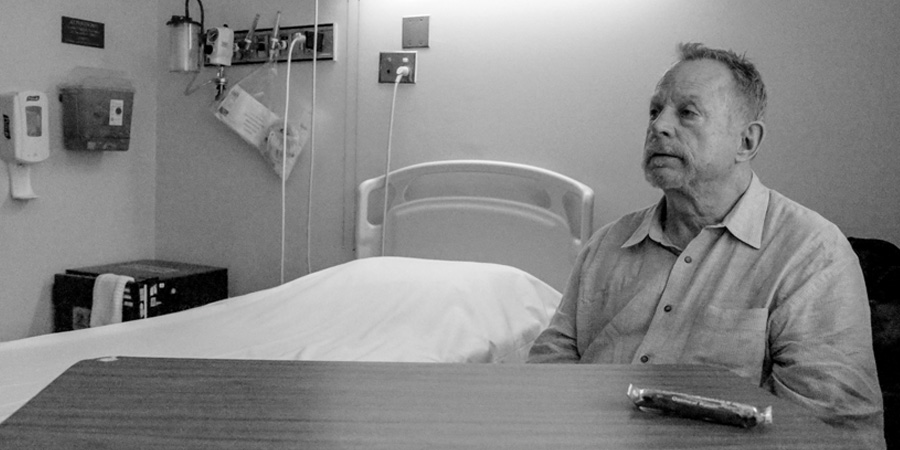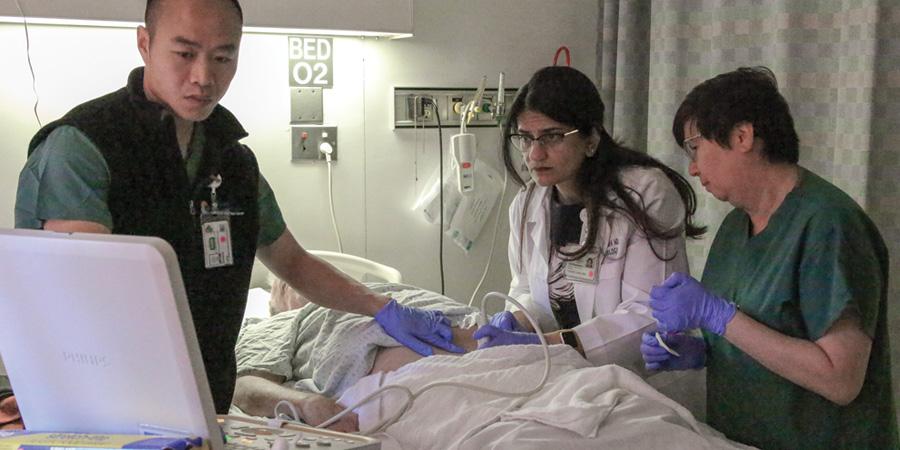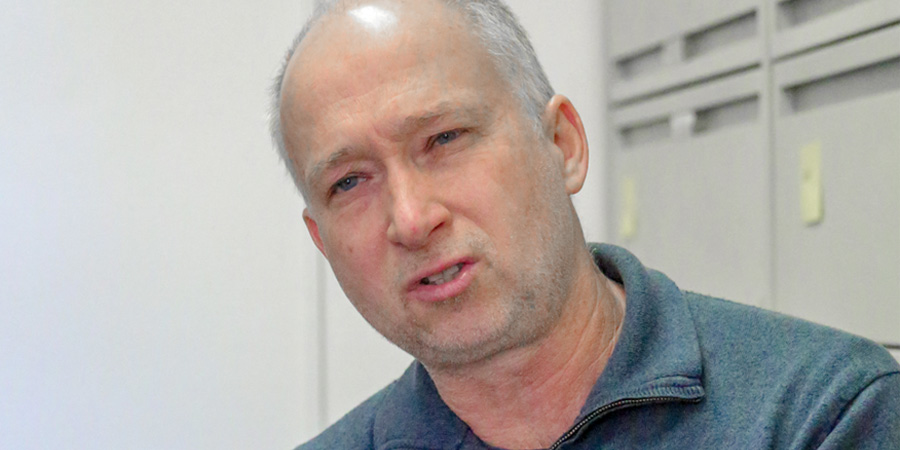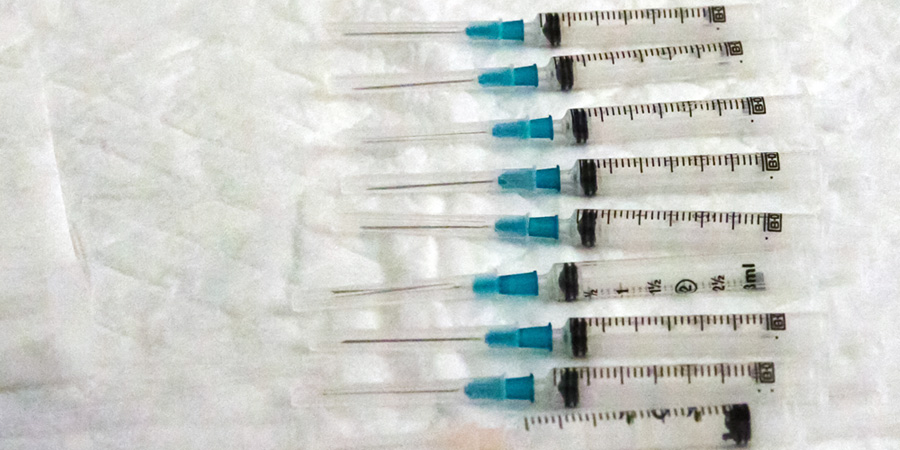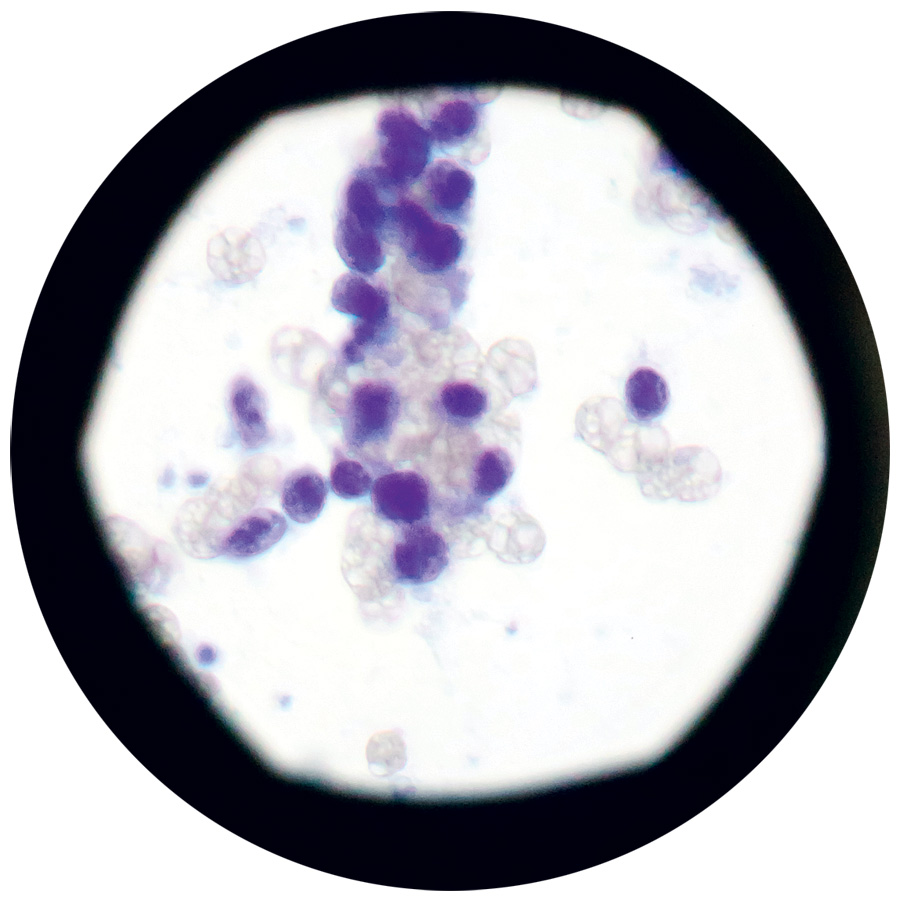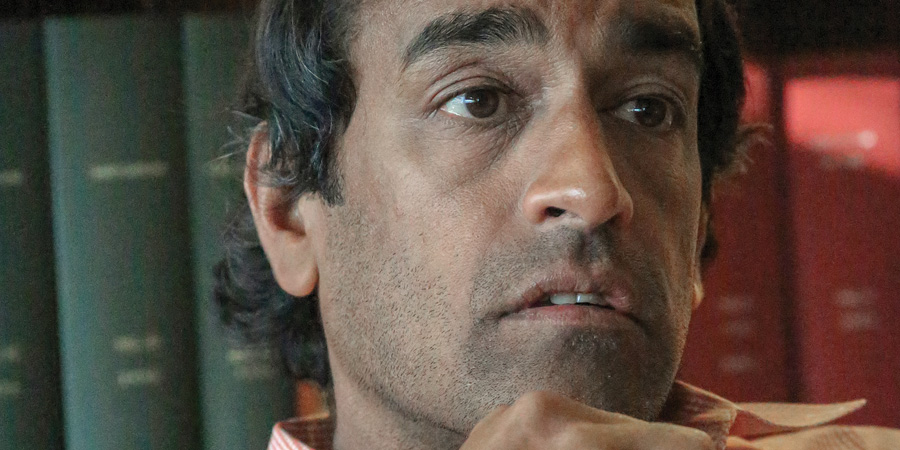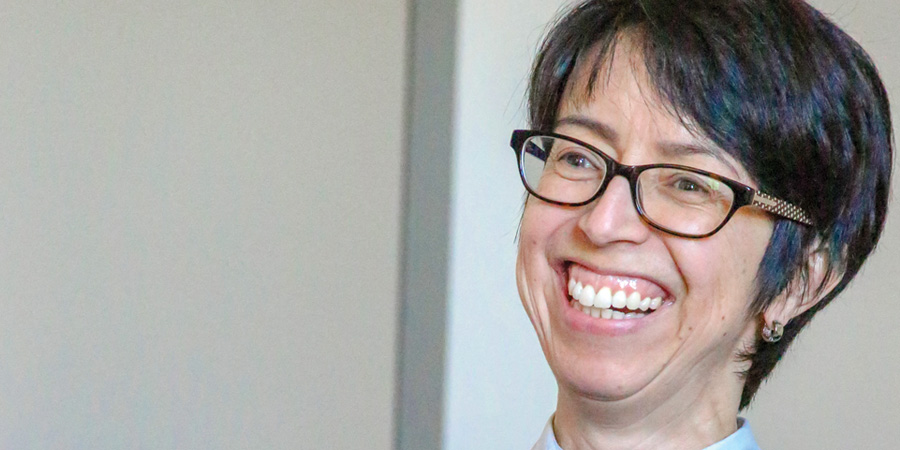
Zuckerberg San Francisco General Hospital and Research Center’s Building 80, home of the world’s first dedicated HIV clinic, serves over 3,000 patients and is the center for a new clinical study of remission—a step toward a cure.
On a recent March morning in the neighborhood of Potrero Hill in San Francisco, the day dawned cold but bright. The main entranceways to the sprawling Zuckerberg San Francisco General Hospital and Research Center were blocked by construction, forcing employees and visitors to groan and take the long way around a warren of massive red brick buildings and pavilions that make up the century-old medical complex. Few of them were likely aware that, in the wake of the 1906 earthquake, the original hospital that stood here was razed and rebuilt to rid it of plague-infested rats. Construction has rarely stopped since.
Upstairs inside Building 80, however, the mood was one of calm. A sign in the hallway alerted new visitors to the special history of this unit, famous Ward 86, the world’s first dedicated HIV clinic. It opened in 1983, when HIV was still called GRID—gay related immune disorder—and quickly became a model of compassionate clinical care that was linked to collaborative research. Today, Ward 86 serves 3,000 patients, mostly locals, including women; 80 percent are on HIV treatment. Some 80 people including staff, volunteer providers, and faculty work there. It’s also a field site for nearly 2,400 volunteers of an observational study of HIV called SCOPE that’s emerged over time as a unique cohort of long-term survivors and a younger generation of the Bay Area’s LGBTQ community.
Ron Malone, a gay man of 69, is among them. He first arrived at this clinic in 1993, breathing heavily eight years after his HIV diagnosis. At 5’10”, his body was weakened by Pneumocystis carinii pneumonia (PCP), a marker of failing immune health and AIDS. Up to that point, he’d eschewed experimental drugs that had major side effects. At Ward 86, he met Dr. Steven Deeks, a young turk in the AIDS ward who asked if he’d like to join a clinical trial of a promising new drug: a protease inhibitor. “I’m glad I said yes to that question,” Malone chuckles. In 1995, when the first HIV protease inhibitor was approved for prescription use, Malone was among the Lazarus-like cases of recovery. “That’s how I got into the pipeline for drug research,” he adds. “These folks saved my life.”
Malone makes the trip from his home in South San Francisco to the clinic pretty often. Sometimes it can take him longer than forty minutes. But traffic was light today; he’s on time. Most SCOPE participants are seen quarterly for a check-up, including blood work. Volunteers like Malone sign up to go the extra mile. “I’m happy to do whatever they need,” said Malone, who calls himself a Ward 86 vet. “It gives me a sense of purpose. This place and these people are sort of like family to me by now. It’s an opportunity to contribute what I can to the fight. At this point I don’t even feel like just a patient; I consider myself a member of the team. We’re in this together.”
Today Malone is contributing a tissue sample from his left groin lymph node. The operation is called a sonogram-guided FNA, or Fine Needle Aspiration, and it’s a relatively easy procedure, but it involves multiple syringes and requires him to lie very still. This is Ron’s second FNA. Before this, he’s had an excision of one of his lymph nodes, tissue removed from his lower colon, and given copious amounts of blood. Such specimens have contributed to an impressive SCOPE repository of biologic specimens used by researchers around the world. To date, the SCOPE cohort has supported over 100 cure-related studies. Malone heard that scientists were short on lymph node tissue and white blood cell samples needed for new studies and quickly signed up.
‘At this point I don’t even feel like just a patient; I consider myself a member of the team. We’re in this together.’
—RON MALONE
Right now Malone is sitting in a corner chair of inpatient Ward 5B on the hospital’s fifth floor as he chats, having a routine blood draw and his vitals taken as prep for the FNA. Minutes later, he’s lying down in a hospital bed as the nursing team quietly files in, a picture of efficiency and best practice techniques. They clean their hands and don gloves. A smiling male technician from the FNA team shifts a sonogram machine into position just across from Dr. Poonam Vorha, a pathologist, and adjusts the room’s pink curtain; the morning light is interfering with a clear view of the monitor. Dr. Vorha smiles at Malone and quickly reviews what will take place. She’ll be taking several samples today. The procedure shouldn’t hurt—a little pinch—and will be over pretty quickly. “Try to stay still,” she reminds him. Malone nods. He’s a study vet: been here, done this. Piece of cake.
Nearby, a small rolling table is set up with five syringes, and plenty of alcohol swabs. Malone’s groin area is swabbed with antiseptic, then gel for the sonogram wand. A Ward 5B nurse reviews the informed consent form. The paperwork is in order. Time to start.
For several minutes, all eyes focus on the enlarged image of Malone’s lymph node as the first needle gently penetrates his skin, then the perimeter of the node. Dr. Vorha’s hand moves imperceptibly. The needle moves to an inner chamber of the node called the cortex that contains T cells and B cells of the immune system. T cells are among the primary target cells of HIV infection.
SCOPE volunteer Ron Malone undergoing a groin lymph node fine needle aspiration (FNA) procedure.
Malone smiles, encouraging her to carry on. He’s curious about what she’ll find. He’s been on successful daily HIV treatment for 25 years, and his HIV levels remain undetectable on standard viral load blood tests. That means he can’t pass on the virus to others, a finding confirmed in major clinical trials. It prompted the slogan: U=U, undetectable equals untransmittable.
But is he totally free of HIV? Here, many studies have shown that a small residual pool of HIV may still exist in individuals on therapy. Copies of the virus—a few here and there among millions of cells in tissue—are trapped inside dormant immune cells. This latent pool is known as the HIV reservoir. Studies show this latent virus almost always ignites a rapid viral load rebound in individuals should they stop therapy. Unfortunately, standard HIV tests can’t detect HIV in tissue compartments.
In recent years cure researchers have been hotly focusing their efforts on eradication and control of HIV in the latent HIV reservoir. It’s the new frontline of the AIDS war. While the Holy Grail is complete eradication of every last particle of HIV—also known as a full cure—many research groups are targeting the next best thing: remission, or a functional cure. This approach combines novel antiviral agents with vaccines and immune-boosting agents designed to keep HIV in check. The goal is to try to build on the immune protection seen in “elite controllers”—rare individuals exposed to HIV with undetectable or very low HIV levels who typically go years, even decades, before developing symptoms; some cases of “exceptional control” may never see disease progression.
To date, only one person is deemed completely “cured” of HIV: the famous Berlin Patient, Timothy Ray Brown. He was cured of both HIV and a serious cancer in 2007 after getting a stem cell transplant from a donor with a genetic resistance to HIV. In another case, Mayo Clinic scientists in Rochester, Minnesota induced remission for 288 days after stopping HIV therapy in an individual who also received chemotherapy and a stem cell transplant. There are also growing reports of individuals treated with HIV drugs very soon after exposure who have seen periods of remission from months to years after stopping therapy. They include cases referred to as the “Mississippi baby” and two Boston patients. The SCOPE cohort includes a significant number of elite controllers; Timothy Ray Brown also joined the cohort.
At Ward 86, Malone’s longtime doc Deeks is embarking on a new clinical trial aimed at remission in both newly infected individuals and long-term survivors. Malone is jazzed, though he may not qualify, being almost 70. “It keeps me active to be in the medical world, and I feel like I’m getting something out of it too,” says Malone. “It keeps me hopeful.”
In 1992, AIDS deaths in San Francisco reached an epidemic zenith, peaking at 1,641, becoming the leading cause of death in U.S. men aged 25–44. i Back then, Steven Deeks was a fresh-faced doc training at the inpatient ward at San Francisco General. There were only three approved HIV drugs, AZT, ddI and ddC, and little to halt the spread of disfiguring Kaposi’s sarcoma lesions or creeping blindness from cytomegalovirus—two illnesses linked to HIV’s attack on immune defenses. The weekly death toll was high. Deeks recalls the environment as very depressing. The picture shifted when Dr. Paul Volberding, a cofounder of Ward 86, invited him to work at the outpatient clinic. Deeks found his calling.
“This position started off in 1993 as a one-year job for me in between my residency and fellowship,” recalls Deeks. “I got to know this cohort of young men who were highly engaged in the disease. It was a very inspiring time for me because that’s when things started to get better.”
It’s mid-March. Deeks is sitting—hiding out, he jokes—in a narrow cubicle office of Ward 86, fielding phone calls and preparing to meet patients. He’s a super busy guy, and soon he’ll be even busier with the launch of a major clinical trial sponsored by amfAR’s Institute for Cure Research. Deeks is the study’s PI, or Principal Investigator; he’ll work closely with Volberding, now co-chair of the Center for AIDS Research at the University of California, San Francisco (UCSF) with Warner Greene (read the online-only feature about Warner Greene on positivelyaware.com), longtime collaborators Peter Hunt and Teri Liegler, and Afam Okoye, an Oregon Health & Science University staff scientist. With the trial still a few months away, Deeks says he’s “putting all our ducks in a row,” to address regulatory and logistical issues.
Early on, Deeks found he enjoyed collaborating with his patients and other doctors (see “The Team Player”). He’s a team player, one who enjoys wearing multiple hats. He’s a professor of medicine at USCF with a patient caseload at Ward 86, and co-director of the SCOPE cohort. He’s a fan of translational research—a “bench to bedside” model that seeks to apply insights from basic science—the bench—into tools useful to doctors with patients—the bedside. “I’ve never seen myself as an immunologist or virologist or clinical trialist or this or that, but someone who tries to merge these in the same program,” says Deeks. “It’s always at those transition points in science that I find the environment to be the most exciting and the chance for innovation to be the greatest.”
That’s the approach Deeks has taken to the pending trial, where he’s tried to “bring the best brains in the room together” to debate and help shape its design. Today Deeks co-chairs the International AIDS Society’s Toward an HIV Cure Initiative and is a Principal Investigator in the Delaney AIDS Research Enterprise (DARE), as well as a member of amfAR’s original Research Consortium on HIV Eradication (ARCHE) collaboration. Longtime colleagues at UCSF and the Gladstone Institutes are key collaborators in the study.
‘It is by far the most complex and challenging study I’ve ever done.’
Deeks got the idea for his newest cure-related trial last fall after reading a December 2016 Nature paper by Dan Barouch, a leading immunologist at the Beth Israel Deaconess Medical Center (BIDMC) who’s been developing novel HIV vaccines for years. In his groundbreaking paper, Barouch published the results of a two-year pre-clinical animal study involving 36 primates that was specifically aimed at achieving long-term remission—sustained control of SIV (HIV’s simian counterpart) off antiretrovirals. His approach combined two vaccines—an adenovirus vector vaccine (Ad26) and an attenuated vaccinia virus vector vaccine (modified vaccinia Ankara strain, or MVA)—and an investigational drug called a TLR7 agonist that can boost virus-specific immune responses.
The animals were first given antiretrovirals for six months to bring their viral levels to undetectable. They were then divided into four groups including a control group that received no drugs. One group got the combo vaccine; the other just TLR7; a third the cocktail of vaccine plus immune booster. Three animals in the last group remained undetectable for a sustained period after therapy was stopped. The study stands as an early proof of concept for the feasibility of what some prefer to call “post-treatment control”—life without HIV pills.
The study also helped pinpoint the specific immune responses that make up what scientists call the “immunologic correlates” of protection against a possible HIV rebound. Other groups have also published data on potent TLR7 and TLR9 agonists.
While Barouch was testing his novel cocktail, Deeks and colleagues at the amfAR Institute were also tinkering with TLR7 agonists, which are well known to cancer researchers. In fact, cancer is seen as a model for HIV cure research. Deeks began working with Bob Seder at the Vaccine Research Center, and colleagues at the Infectious Disease Research Institute in Seattle, as well as industry colleagues at Gilead. “That paper in Nature really stimulated our group,” says Deeks. ii “We began to design a way to model a therapeutic intervention after the Dan Barouch work.”
Last December, Barouch was awarded the 2017 Drexel Prize in Immunology for his vaccine work. By then Deeks had laid out the blueprint for an ambitious study using the same combo cocktail as Barouch’s group, but with a twist. AmfAR colleagues wanted to add one more ingredient: broadly neutralizing antibodies, or bNAbs for short. They’re derived from B cells of the body that can target proteins on HIV’s surface. Neutralizing means kill: studies have shown a single bNAb can lower HIV levels in individuals. But HIV is also a tricky virus; its genes mutate as it reproduces, limiting the potency of single bNAbs. In the September 29, 2017 issue of Science, iii lead author Ling Xu of the National Institutes of Allergy and Infectious Disease (NIAID) tackled that problem by genetically creating a “trispecific” antibody hybrid of three bNAbs that each target a different region of HIV. His “super antibody” provided complete protection against SHIV, a simian-human virus. Xu works in the lab of NIAID head Dr. Anthony Fauci, a longtime collaborator with Barouch’s lab, too.
The broadly neutralizing antibodies now being tested in various trials target fixed, or conserved, regions of the virus, making them effective against 99% of HIV viral strains including drug-resistant ones—a welcome addition to the arsenal. On March 4, Barouch’s lab presented more promising data from a rhesus monkey study at the 25th Conference on Retroviruses and Opportunistic Infections (CROI) in Boston. A combination of a TLR7 agonist made by Gilead Sciences and a bNAb known as PGT121 resulted in a six-month period of remission. iv
Now come the human studies. Deeks plans a novel combination of a DNA vaccine, an MVA boost, a TLR9 agonist, and a potent bNAb, administered sequentially. That approach will allow researchers to evaluate the impact of each single intervention, and their combined power.
Clinical trials are notoriously difficult to put together, time-consuming, and they involve mountains of red tape. But so far, Deeks’ protocol has gotten a green light from key review bodies, including the Food and Drug Administration. “I’ve gotten remarkably little pushback,” he says, a bit surprised himself by this fact. “The idea has gone forward pretty damn quickly with a tremendous amount of enthusiasm.”
Last year, at an amfAR HIV cure summit, Deeks gave a little preview of what he was dreaming up with the trial. “We’re gonna put together the best of everything we think can work and see what sticks,” he said, breaking it down for a lay audience. His team jokingly calls it the “kitchen sink” trial or “Jaws”—like a big shark aiming at a chunk of the HIV reservoir mystery. Six different investigative groups are involved in the trial—”each with their own lawyers,” Deeks notes, grinning, as well as outside groups.
“We’ve put together a superstar team of investigators,” he adds. “We’re doing something no one has ever done before; we’re pushing the envelope in terms of trial design with this combination approach. And we have the infrastructure to do a high quality study.”
The trial will have two research arms and is expected to take three and a half years to complete. It will recruit 30 individuals in a randomized, placebo-controlled proof of concept study in which eligible subjects will be randomized 2:1 to receive a five-stage combination regimen or placebo. It will also recruit 10–15 individuals with acute/recent HIV infection into a single-arm, open label study using the same regimen. Participants will have been on therapy and undetectable for two years prior to starting the study, with T cell levels above 350. They remain on antiretrovirals for 44 weeks of the study while getting the regimen. They will interrupt therapy after the last dose of their regimen—the added antibody.
Deeks anticipates they’ll remain undetectable at least 12 weeks (through week 56) or see low viral loads, based on the Barouch animal data and other studies. By letting viral rebound rise, he hopes to monitor how much virus is cleared from the tissue reservoir, and if it’s sufficient to allow boosted immune defenses to kick in and reduce viral load levels to undetectable or very low levels—a proof of concept of sustained remission. That would mimic the immune profile of elite controllers. Study participants will be followed until week 96 and allowed to remain off antiretrovirals if viral load is kept low enough.
The trial is designed to test the safety and efficacy of the regimen; a Safety Monitoring Committee will meet biannually to review any adverse reports. The study will recruit from SCOPE and include males and females ages 18 to 65. There are a few exclusion criteria including prior use of non-nucleoside drugs, having hepatitis B or C or liver disease, and taking active chemotherapy or immunomodulatory drugs. Women who are pregnant, breastfeeding, or unwilling to use birth control are out. So are individuals who have a clotting or bleeding disorder or can’t undergo the two-hour leukopheresis, or “leuko pak” procedure. This last item may limit some women’s participation; their veins may be too small to handle the large needle used in that process.
While the broad goal is remission, some call it a 2.0 HIV “shock and kill” study of treatment interruption. It’s that, too. The trial will also provide an opportunity to develop and test new gene technology and diagnostic tools to better measure and map the reservoir and immune responses to HIV. “It is by far the most complex and challenging study I’ve ever done” says Deeks. “The amount of resources necessary to launch the clinical trial is overwhelming,” he explains.
He’s also confident the trial is safe, which, he says, is always his number one priority. “It’s highly unlikely we’ll do any harm because the components have been pretty much well vetted.” Deeks pauses, smiling. “I think people are excited.”
Multiple syringes are needed to perform a Fine Needle Aspiration (FNA).
How likely is it to work? Deeks is more hopeful than ever—but he’s also wary of over-hyping the possible results. “In order for me to justify putting together a combination approach there has to be a scientific justification, and there’s lots of scientific rationale for everything involved in this study,” he states, pointing to data from recent monkey models to oncology. “The rationale is solid and no one has ever asked us for additional preclinical studies to support the rationale.”
Okay, so what does he expect? And how much of a picture can we get of what may happen in the reservoir based on lymph node FNAs and gut samples? A snapshot? More?
“To predict a cure in people you have to be able to cure people,” he stresses. “I mean, I’m interested in what happens when you stop therapy, right? And if we quote-unquote, cure people and put people in remission. We’re gonna measure a million things that we think will control the reservoir in the absence of ART [HIV drugs], and the only way to figure that out is to stop ART. So it’s possible that we will achieve a remission, without affecting the size of the reservoir at all; that’s not necessary right up front.” This is Deeks the clinician talking, the guy who does translational research so lab data will result in positive patient outcomes.
That’s also what worries him the most: the human burden of the trial. Participants will be expected to make 60 to 70 visits to the clinic in 18 months. “It’s intense,” stresses Deeks. The visits will involve an interview, a blood draw, and then the IV drug administration, a process that may take 2–3 hours. “That is going to be happening once or twice a week for a long period of time,” he adds, shaking his head at the thought. “Our concern is that the intensity of the protocol will be so great that it might overwhelm our system,” he admits. “So we’re not entirely sure this will be a single center study.”
Yet that’s not even the hardest part. New challenges will come when it’s time for participants to stop taking their HIV medicines. “The monitoring will go sky high and people are going to have to be concerned not only with what is happening to them but about their interactions with loved ones because of the issue of transmission,” states Deeks. “So there is an intensity during the treatment phase and intensity during the interruption phase.”
Luckily, Deeks has teams of experts to help him consider the ethics dimensions and needs of participants in the study (see “The Community Watchdog”). An independent Institutional Review Board has reviewed the draft protocol and made comments. So has an FDA body, and the group Deeks has come to really rely upon since his early AIDS days: the Community Advisory Board, or CAB. It’s co-chaired by longtime treatment activists and HIV-positive individuals well versed in HIV clinical trials. The CAB had early input on the study’s Informed Consent form and process; they advise on such aspects as recruitment, and inclusion and exclusion criteria, to assure it conforms to best practice norms of clinical research.
But this study also pushes the envelope a little. Prior treatment interruption trials have immediately put individuals who showed signs of a viral rebound back on therapy. But we also know from such studies that when the virus initially rebounds back it may shoot up high, then drop down to a stable plateau or viral “set point.” “It’s about six to eight weeks minimum before we know what’s working,” says Deeks. He wants a threshold of 10,000 HIV copies for the trial; if individuals see rebound levels rise above 10,000 for two visits in a row, they’ll have to get back below that level within two weeks.
That spike in HIV, of course, may not only worry participants, but carries a risk of transmission for their sexual partners, making prevention issues a critical component the study must address. “That’s a constant discussion,” Deeks acknowledges. The SCOPE research staff are very experienced in patient support and retention, and a lot of resources are aimed at helping volunteers manage their participation. Not everyone’s a Ron Malone, who’s pretty stoic and up for anything, and has a supportive partner who can help drive him to distant appointments. “We try to plan for everything, but things come up,” Deeks admits.
‘To predict a cure in people you have to be able to cure people.’
A good example of that are lymph node biopsies. After doing nearly a hundred lymph node biopsies without incident, two SCOPE volunteers had complications with the procedure. While lymph node biopsies provide a more complete picture of HIV activity in the reservoir than a grain-sized FNA extraction, Deeks has decided to stop collecting the tissue samples for now. “We were pretty surprised,” Deeks said, sighing. “A hundred procedures—no problem. Then, boom. But, look, that’s what can happen.”
What about the new study? While the four drugs being tested have been safe in prior studies, this one will combine them in a novel way. Deeks anticipates positive, synergistic drug interactions, not negative ones, but it’s still a question mark. Some first generation “shock and kill” drugs caused side effects and weren’t very effective. That’s why the study calls for such intensive monitoring of participants. “Do no harm,” states Deeks, citing medicine’s dictum. “Even though you can’t predict certain aspects of a trial, you plan as much as you can to avoid any adverse outcomes.”
To the naked eye, Malone’s tissue sample, rubbed onto slides, looks like pretty blue dots. A staining solution has been added to differentiate the cells. One of the nurses carefully packs the samples in a carrying case and, in minutes, is headed down the hallway to deliver them to scientists at collaborating institutions in the trial. Malone’s fresh samples are destined for Dr. Rachel Rutishauser’s lab at Gladstone (read the profile on Dr. Rutishauser). She’s focused on the immune side of the puzzle and vaccines. After Malone, two other SCOPE volunteers will undergo the lymph node FNA today. The team has already completed 50 FNAs for the pilot—an average of five to ten a month.
‘Pretty blue dots’: Freshly extracted cells from a lymph node.
From the outside, the center looks like an ordinary modern office building. But inside, and down a flight of stairs, is a state of the art facility that includes a biosafety level 3 lab—one of a few in the U.S. That’s the kind of lab you see in apocalyptic movies where scientists are heavily suited up in protective clothing and goggles to avoid exposure to a live virus like polio.
The BSRI facility has 9,000 square feet of labs, with a 2,200 square foot freezer room that can store over a million specimens. It’s stacked head to toe with heavy refrigerators and freezers that bear the labels of the specimens inside and who owns them. Here you find Zika, dengue, and of course, HIV. Satish Pillai’s group has laid claim to several big freezers.
The lab team occupies a row of small offices on one floor, but a lot of their time is spent below ground, in the windowless shared lab. It’s a cluttered, busy place, overlit with fluorescent lights that only underscore the lack of daylight. There, senior scientists work with younger graduate students and lab technicians hunkered over microscopes and computers, some listening to music on headphones that help pass the time during long experiments.
Satish Pillai could easily be mistaken for one of the younger protégés. A friendly, self-described ex-Deadhead and math geek, Pillai loves music so much that he relies on it to help him relax and think conceptually about his lab work. He’s a rising star in the field of HIV diagnostics and is responsible for the laboratory side of the coming remission trial. Last year, he gained attention for a PCR (polymerase chain reaction) testing method that can assess 1 million cells using a digital droplet technology, compared to prior methods limited to 100,000 cells or less at a time.[i]
‘While the big goal is remission, the development of these new technologies is also an important outcome of such studies.’
—Satish Pillai, HIV Laboratory Expert
Pillai’s lab is tasked with developing and testing new technologies and tools that will help assess the impact of the planned regimen. “We want to shrink the size of the virus reservoir and then we want to manipulate the immune system so that, even if we can’t achieve complete eradication, the immune system is primed in a way that can control any of the residual virus that escapes after the reservoir reduction that we attempt,” Pillai explains. That’s the big picture in a nutshell. “My goal is to come up with strategies to measure those things: ‘Have we actually reduced the reservoir?’ That’s number one. ‘Have we manipulated the immune system in any way that there is a likelihood that we can control any of the embers that persist?’ That’s number two.”
He’s nodding to himself as he ticks off that list, then pauses, his expression reflective. “The thing is, we don’t have any off-the-shelf tools we can use to measure that. The HIV reservoir itself is a very nebulous concept,” he explains, and the cure field lacks industry standards to measure HIV latency. “That’s where we come in. A lot of what we have done in the amfAR Institute is to develop a range of tools to measure the reservoir using different approaches, targeting different components of the virus.”
A key aspect of the planned combination trial is being able to map and reduce the infectious HIV pool. To do that, we need tests that can distinguish between T cells that harbor a defective HIV provirus, or viral genome, and can’t reproduce, and T cells with proviruses that can replicate and are infectious; the latter pose a danger of re-infection (see “The Mapmaker”). “We really need to be able to discriminate between infectious viral genomes and the replication-incompetent duds,” Pillai explains, using more wonky language. “We are trying to get our technology up to the point where you can take clinical samples and actually look to see if our interventions—even if they don’t change, for instance, the frequency of HIV DNA in circulation—do they dramatically impact the frequency of replication-competent virus? Because that would be a very meaningful deliverable.” Put more simply, he’s hoping to measure just how big a bite the trial regimen may take out of the important piece of the reservoir pie.
Timothy Henrich at UCSF is also looking at markers on CD4 T cells that might flag them as harboring infectious HIV (read the online-only feature about Henrich at positivelyaware.com). His lab has evidence that the cellular receptor CD30 may be a candidate “biomarker” and that rising CD30 levels may be a harbinger of a viral load rebound in people experiencing a transient period of remission after HIV treatment interruption. v That could turn into a future diagnostic tool to help individuals assess the risk of a treatment interruption. “We hope to apply our know-how and look in more depth for these markers in the trial,” Henrich says.
What about the big paradigm shift we’re after: long-term immune control of HIV? How do we elicit the exact immune defenses that will stop HIV, and restore lost or missing immune strength in individuals with chronic versus acute HIV infection? While so much of our long fight against HIV has focused on developing antiviral drugs, the new frontier is the immune system: how to harness nature’s power. Can we identify the right mix of immune responses we need to prevent HIV from rebounding?
In the SCOPE cohort, studies of elite controllers have given us some clues about what’s needed: CD8 T cells (CTLs) can target the virus (called “HIV-specific”) and help suppress HIV replication. The Barouch monkey study that combined a therapeutic vaccine with a TLR7 agonist found that specific T cell responses to the HIV proteins Gag and Env were associated with control of viral rebound.
In the trial, Gladstone’s Rutishauser will be responsible for analyzing HIV-specific T cell responses. Like Pillai, she’s optimistic about what the study may teach us—even though we don’t know exactly what type of immune response may predict success. “I think we can come close to understanding whether a robust immune response has been elicited,” says Rutishauser, “and now we can do that so much better than we could even five years ago given the immunologic tools that we have.” She’s busy testing a new flow cytometry tool called mass cytometry that can analyze a dizzying array of 40 different possible T cell functions simultaneously.
She’s also hoping to apply insights from elite controllers: “All the knowledge that we’re getting about what constitutes a good T cell in natural controllers can inform that really well, in terms of being able to say, ‘Are these CD8 T cells similar to that or not?’” she explains. Right now, she stresses, much more needs to be learned about what’s happening with T cell responses in tissues, and how the desired immune responses might be directed to where they’re most needed.
The study team is also eyeing the potential of natural killer (NK) cells to play a part in remission. Lab studies show that NK cells have the potential to bind to HIV-infected T cells in the reservoir, flagging them for destruction. This mechanism is called antibody-dependent cellular cytotoxicity (ADCC).
Pillai also plans to assess immune system pathways likely to be affected by the TLR9 agonist, particularly the induction of interferon, an immune system protein with antiviral properties. Meanwhile, Pillai’s colleague Konstantinos Georgiou will probe “host restriction factors”—enzymes produced within cells that aren’t traditionally considered part of the immune system but have HIV-suppressing capacity. The best-known example of such an enzyme is the tongue-twister, APOBEC3G (see “The Mapmaker”).
Pillai is also hoping that some cases of prolonged control of HIV viral load will be observed in the trial, because of the opportunities that it will open up. “I’m really crossing my fingers,” he says, “If we do, the tools that Konstantinos and our whole tech crew are working on will really help us zero in on the particular immune mechanisms that were primed to allow for that extended control. That should give us a whole new generation of ways to manipulate the immune system to have that effect.” While the big goal is remission, the development of these new technologies is also an important outcome of such studies.
Midmorning. Back at Ward 86. SCOPE’s clinical research coordinator Becky Hoh and several members of the research staff are huddled in conversation, reviewing a tightly scripted schedule of the day’s appointments. The schedule is always a moving target; flexibility is essential. Usually by 9 a.m., people have cancelled, changed, or asked to drop in. When that happens, the SCOPE team has to notify labs or scientists who may be waiting to receive fresh samples, or a visit from a participant being referred for an outside field procedure. A large clinical trial demands a high degree of choreography to run smoothly: people need to know their roles and when they are needed to show up, including the volunteers. That’s where Hoh gets high marks from her colleagues and boss Deeks: she is well organized, calm, highly experienced, and, most important of all, she’s a people person—she loves her patients.
“A lot of it is coordination, logistics, communications, asking patients, and making sure expectations are met,” says Hoh, laying out the day-to-day demands of managing the SCOPE cohort and myriad studies. While Pillai dreams about biomarkers and how to map the molecular world inside the bodies of participants in the study, Hoh and her staff focus on the emotional side of their lives: what it takes to support them, how to balance the hope that naturally comes with such a trial against the fatigue and discomfort that may follow a lymph node FNA or a two-hour leuko pak session.
“We definitely want to make sure that folks have an idea of what they are going to do here,” explains Hoh. “We never want people to show up and not know what is going to happen that day, what they need to prepare for a visit. If it’s a procedure like a colonoscopy, we’ve already been in touch with them two or three days beforehand to say, ‘Hey, we would you like to have everything ready. Is there a special diet that you follow? Do you have the instructions you need?’ ”
“It’s amazing how many people are still in SCOPE,” says Hoh, who started at Ward 86 in the 90s (see “Doctor Steven Deeks”), “but certainly some go away and come back. You never know when you are talking to somebody about a study that may take a year to complete, what is going to happen in that time: there may be health changes, relationships change, a lot happens. But I have to say, for all of us working on the team, that working with patients is the best part of the job… the relationships you build. You are hearing their stories and you are working with people who are generous and want to contribute.”
Two words come up over and over again in conversations with both staff and clients in the SCOPE cohort: trust and inspiration. “I do trust them; they have taken such good care of me,” Malone says. “I feel inspired to be here.” Study coordinator Hoh agrees: “We feel a great degree of trust and respect for our patients. They inspire us to do our best. We always learn from them.”
That trust begins with a tool that serves continually as the reference point and ethical compass for all parties in a trial: the informed consent form and process. Hoh and her colleagues get ahold of the draft informed consent early on, even before an outside Institutional Review Board or the patient Community Advisory Board, or CAB. All review parties are tasked to make sure the protocol conforms to ethical and best practice standards. They look closely at inclusion and exclusion criteria, what will be asked of volunteers, the benefit vs. possible risks. All of the SCOPE team have clinical research backgrounds.
‘...working with patients is the best part of the job.’
Becky Hoh, SCOPE clinical research coordinator
For this study, the CAB co-chairs are two longtime HIV activists who have sat on clinical trials over the years: Jeff Taylor, who’s been HIV-positive for 35 years, and Lynda Dee, who’s been doing HIV advocacy for 33 years (see “The Community Watchdog”). Both are outspoken, intelligent activists who can hold their own with researchers when it comes to deep geek science.
CAB members see themselves as having two key roles in such studies: the first is as community watchdogs to ensure the safety and participation of volunteers; the second, to do outreach and educate the larger and local HIV community about the study. Throughout a long trial, they solicit the community’s views and concerns, and bring that feedback to the investigators. The UCSF study is among the first human remission studies to get rolling, but similar studies are ongoing or planned elsewhere, including globally. What happens in SCOPE will inform other sites, and vice versa.
At the moment, the main thing that preoccupies Dee and her colleagues is the part about stopping therapy, known as an “analytical treatment interruption,” or ATI, in CAB-slang. “Everybody’s doing them,” says Dee referring to remission studies, “and they’re doing them with very capricious sorts of metrics just like we did in the beginning of antiretroviral trials. But in those days, you know, people were beating the doors down because they were dying.” She wants to move with caution: “I think the biggest ethical issue we face are these ATIs, and we have to be really, really sure that they [are as] safe as they can be—especially these initial ones going right from monkeys into people.” She’d like to see inclusion/exclusion criteria be a little—she searches for the words—“more safe, less risky; let’s put it that way.”
Dee has made it her personal mission to ensure the CAB has diversity, and she’s invested in helping mentor less-experienced CAB members who are new to cure trials. “It’s not been easy to get a diverse group,” admits Dee, a Baltimore resident who enjoys a good challenge. “But it’s a really good little group and we’re devoted to making sure women and people of color are included.”
Dee and Taylor have known Deeks and other co-investigators for years; when they speak, they’re listened to. They want the same to be true of their newer CAB colleagues. “They know me; they know that I do what I say I’m going to do,” Dee says about the other parties in the study—including the FDA. “They always say I keep them honest,” she laughs. “So I think that’s my role anywhere in this activism.”
Right now, that honesty means she’s not holding back about her concern that more effort may be needed to make sure women and folks of color are recruited. After years of HIV activism, she’s well aware that fear, misinformation, and denialism about HIV may pose hurdles to participation for some members of vulnerable communities. She cites the infamous Tuskegee experiments in which African Americans were allowed to get sick in the ostensible name of scientific progress. Given historic racism, and exclusion from research, she is attuned to the need for research studies to make community education and outreach a priority.
Can we identify the right mix of immune responses
we need to prevent HIV from rebounding?
At last year’s amfAR cure conference, two SCOPE members shared the stage with researchers: Clark Hawley and Luis Canales. The duo represent the newest poster boys for HIV remission (see “Double Take”). Both men had enrolled into a PrEP demonstration project in San Francisco, but were found to have acquired HIV during a short window of time between undergoing screening tests and being prescribed their first dose of Truvada PrEP. As soon as HIV infection was confirmed by PCR viral load test, they were switched to combination HIV treatment regimens—an estimated 17 days after infection in Hawley’s case, 24 days for Canales. Hawley is believed to be the most rapid case of adult treatment initiation ever documented, with Canales not far behind.
Both men were then enrolled in SCOPE, where researchers closely tracked their status. For over two years, no sign of HIV could be found in their blood or body tissue. Were they now cured?
To find out, Hawley stopped taking his HIV drugs and remained undetectable for over seven months until HIV reappeared. Meanwhile, researchers found evidence of HIV in Canales’ cells when they were put into mice with humanized immune systems. In both cases, early treatment reset the clock, limiting HIV’s spread. The duo represents a small number of individuals who, via early interventions, may achieve remission more easily than those with chronic infection. The smaller arm of the new study may tell us more.
Both men are familiar figures at Ward 86 and the inpatient Ward 5B, where Deeks is now building a new cohort of “exceptional controllers”—a subset of elite controllers who show evidence of HIV but have functional immune systems, and no signs of residual inflammation—a hallmark of chronic HIV infection. Right now SCOPE has four such individuals. “They are probably the people we need to base our cure work on,” says Deeks. “Some people have less than 50 copies of HIV, and others are essentially so close to being cured that they in fact might meet some definition of a cure.” That said, his heart is with the vast majority of individuals like Malone, living for years with HIV, who dream of remission, never mind a cure. Deeks hasn’t forgotten the early days at Ward 86, either.
A week after the CROI 2018 conference, Deeks has run into a snag. He’s not going to be able to get the potent antibodies in time for the start of the trial. The manufacturing of the novel antibodies is difficult and very costly, a painstaking process. There’s not much supply of these agents out there. The trial design will thus have to be tweaked; the antibody given in year two. “I think we should still be okay,” says Deeks. “It’s not a deal breaker.” Luckily, the hiccup has come before final FDA approval. “We’re still on track,” he sums up. “So far, so good.”
FOOTNOTES
i ucsf.edu/news/2011/06/9971/thirty-years-aids-timeline-epidemic
iii science.sciencemag.org/content/early/2017/09/19/science.aan8630.full
v journals.plos.org/plospathogens/article?id=10.1371/journal.ppat.1006856 Hogan LE, Vasquez J, Hobbs KS, Hanhauser E, Aguilar-Rodriguez B, Hussien R, et al. (2018) Increased HIV-1 transcriptional activity and infectious burden in peripheral bloodand gut-associated CD4+ T cells expressing CD30. PLoS Pathog 14(2): e1006856. doi.org/10.1371/journal.ppat.1006856



